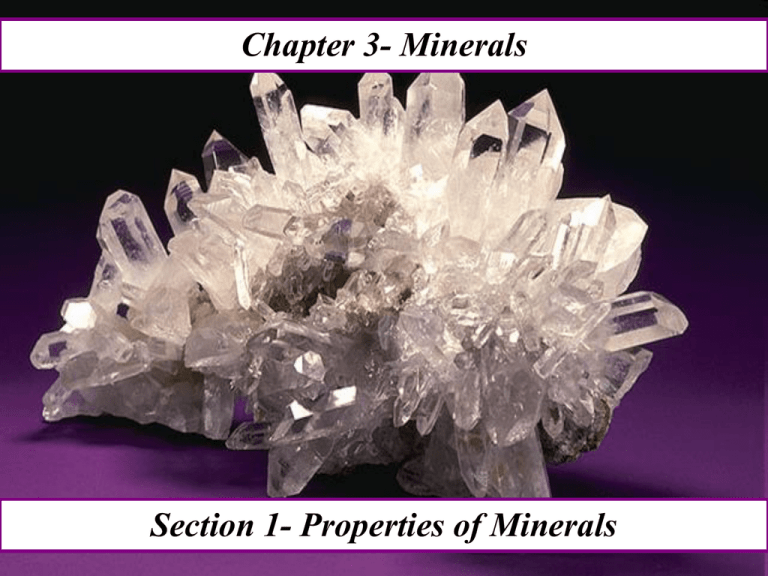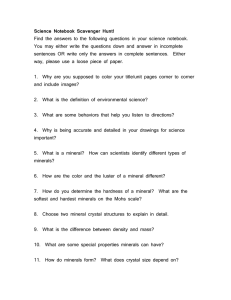What is a Mineral?
advertisement

Chapter 3- Minerals Section 1- Properties of Minerals What is a Mineral? • Mineral= a naturally occurring, inorganic solid that has a crystal structure and a definite chemical composition 5 Characteristics of Mineral 1. Naturally occurring- found in the natural world - Not natural (plastic, steel, brick, concrete) 2. Inorganic= not formed from a living thing or once living thing What is a Mineral? 5 Characteristics cont… 3. Solid 4. Crystal Structure - Crystal= the repeating pattern of a mineral’s particles 5. Definite chemical composition (make-up)= contain certain elements in a definite proportions Identifying Minerals? 5 Tests for Identifying Minerals 1. Color 2. Streak color - Streak= the color of a mineral’s powder * Done by rubbing the mineral across a tile Identifying Minerals? 5 Tests for Identifying Minerals cont. 3. Luster= measure of light reflected from a mineral’s surface - (Can be described as glassy, pearly, waxy, silky, metallic) 4. Density= mass (weight) of an object in a given space Density = Identifying Minerals? 5. Hardness - Mohs hardness scale= a scale which ranks 10 minerals from softest to hardest * Done by scratching the mineral with objects of varying hardness (Example: fingernail=2) Identifying Minerals? • Minerals can also be identified by how they break apart. Cleavage 2 Ways Minerals Break 1. Cleavage= when a mineral splits along a flat surface 2. Fracture= when a mineral breaks apart in an irregular way Fracture Section 2- How Minerals Form How Minerals Form? • Crystals form by crystallization= a process by which atoms are arranged to form a crystal structure 2 Methods of crystallization 1. Molten material 2. Materials dissolved in water Cave of Crystals in Mexico Minerals from Magma and Lava • Magma= molten material from inside the earth that hardens to form a rock • Lava= magma that reaches the surface * When magma and lava cool they form crystals • Rate of cooling determines crystal size - Slow cooling large crystals (magma) - Quick cooling small crystals (lava) Minerals from Solutions • Solution= mixture in which one substance is dissolved in another - For example: Kool-aid in water • Geode= a rounded hollowed out rock lined with mineral crystals - Formed when water enters rock through a crack and elements begin to crystallize on rock walls Geode Minerals from Solutions • Minerals can also be formed from… - Evaporation of a solution leaving behind the minerals - Hot water solutions As hot water heated by magma begins to cool the elements in the water can escape and crystallize in veins= a narrow channel of mineral that is different from the surrounding rock Gypsum Rose Gold Vein Section 3- Using Mineral Resources The Uses of Minerals • Gemstone= a hard, colorful mineral that has a brilliant or glassy luster (Ruby, Opal, Sapphire, diamond…) - Jewelry, decoration, mechanical parts for grinding and polishing • Metals (Aluminum, iron, copper, silver) - Very ductile and malleable - Building frames, cars, money, jewelry The Uses of Minerals • Other Uses (In foods, medicines, fertilizers and building materials) - Talc talcum powder - Quartz glass, electronic parts, and watches - Gypsum wallboard, cement, and stucco Rough Beginnings • Minerals are obtained in the form of an ore= a rock that contains a metal or other useful mineral that can be mined and sold as a profit Making Metals from Minerals First they must be undergo… - Prospecting- find the mineral - Mining- dig up the mineral - Smelting- melting down and removal of unwanted material from the wanted mineral Making Metals from Minerals • Further Processing - Alloy= a solid mixture of a metal and one or more elements Ex: iron + carbon= steel *Why an alloy? - Can give the metal better qualities (stronger, rust resistant, shinier) Ex: Steel + manganese makes stronger steel







